These yeasted gluten-free pumpkin donuts are fried to crisp golden perfection with a spiced pumpkin dough that fluffs up into a super soft airy donut. That classic donut-shop taste - now made gluten-free. Make them as traditional rounds, donut holes, or go hog wild and leave no holes and pipe them full of apple butter. This recipe works as a weekend project or a quick make-ahead dough that rises overnight in the fridge.
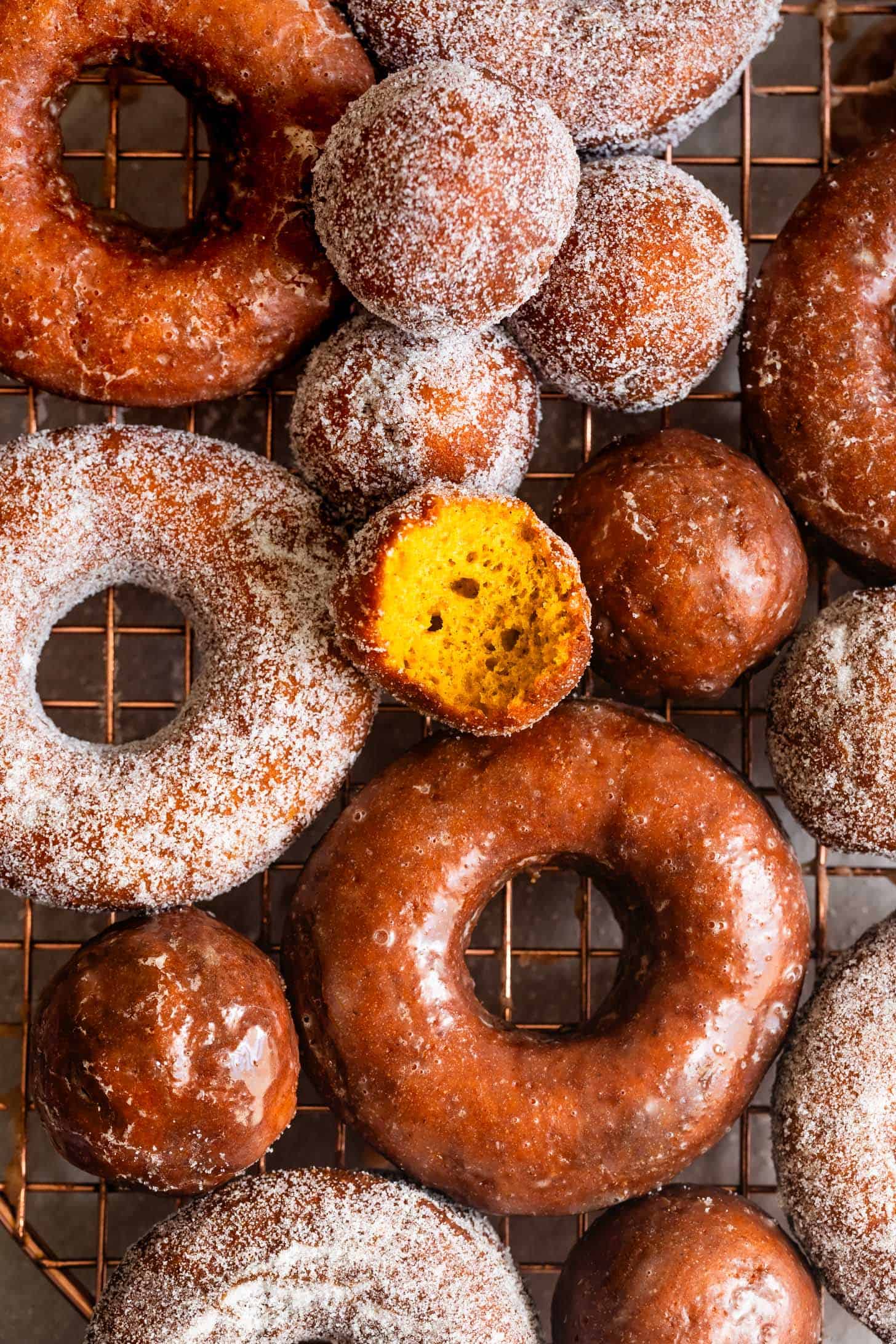
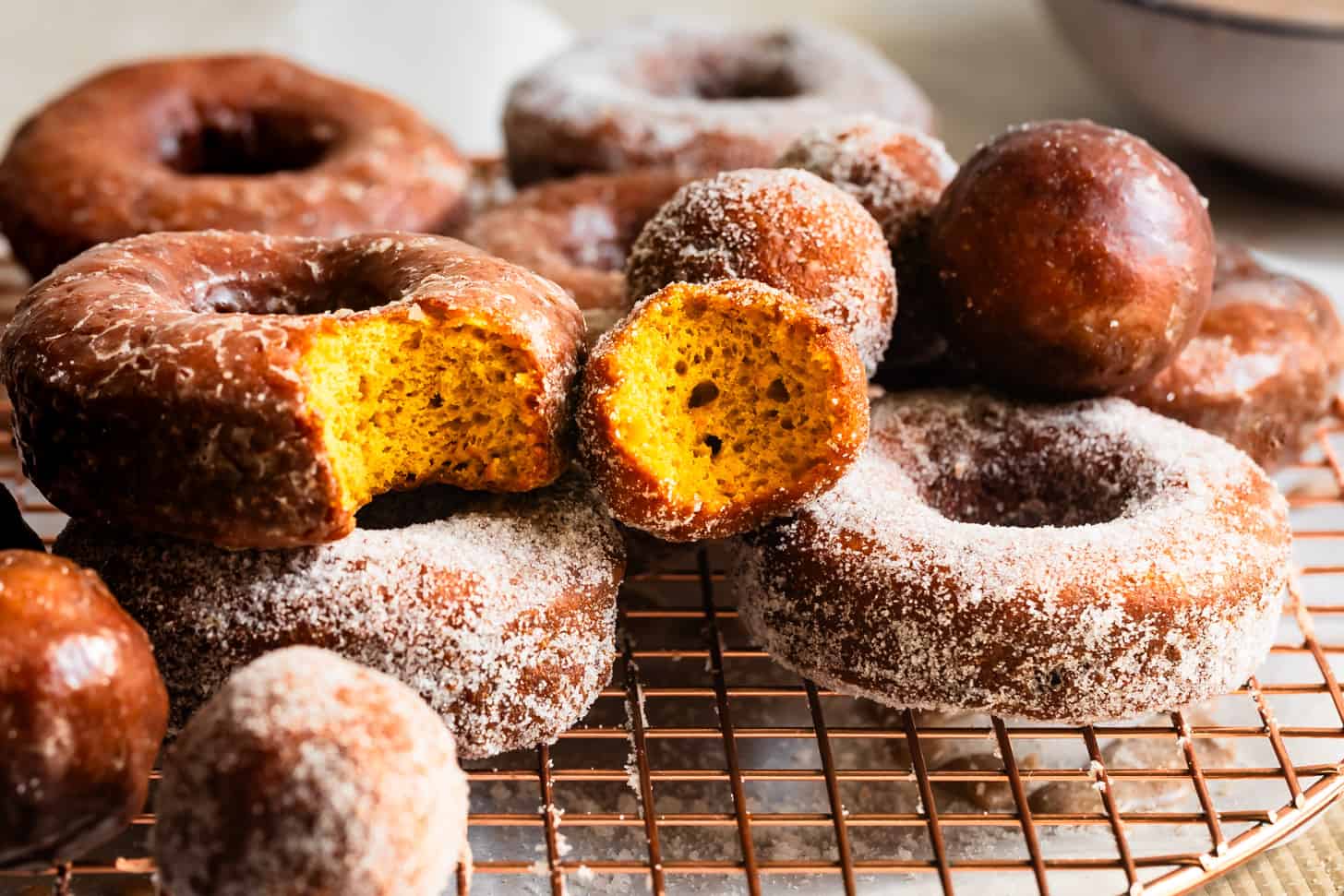
The Best Gluten-Free Pumpkin Donut Recipe
These donuts are a total dupe for traditional glutenous donuts, with a pumpkin twist. I served these freshly made gluten-free pumpkin doughnuts to my neighbors who each said some form of "but these aren't gluten-free right?" as if the reason I was sharing was because I could not eat them myself.
I adapted this fall-forward recipe from my classic gluten-free yeasted donut recipe. With a crisp golden brown shell and a spiced pumpkin dough that fluffs up into a super soft airy donut, these donuts are perfection. Make them as traditional rounds, donut holes, or go hog wild and leave no holes, piping them full of apple butter.
Gluten-Free Yeast Donuts
These pumpkin donuts are fried yeast donuts, which are distinctly different than cake donuts. As the name implies, gluten-free yeasted donuts get their leavening from yeast. These are what most classic glazed donuts are, including Krispy Kreme donuts. The dough is cut into a donut shape and deep-fried. With only a lightly sweetened dough, most of their sweetness comes from the glaze. The texture of yeast donuts is airier with a crisp fried shell.
Most homemade donut recipes on the internet are baked cake donuts. Cake donuts are essentially sweetened cake batter leavened with baking powder. At a donut shop, cake donuts are extruded and fried, but at home, most cake donut recipes call for baking in a donut tin. In my (biased) opinion, baked cake donuts just taste like cake with icing. I'd rather just have cake, more of the fluffy inside with less of the dry crust that a donut pan creates. If I'm eating a donut, gimme that crispy fried kind.
(One exception to my cake donut opinion is mochi cake donuts, which I argue belong in its own third category).
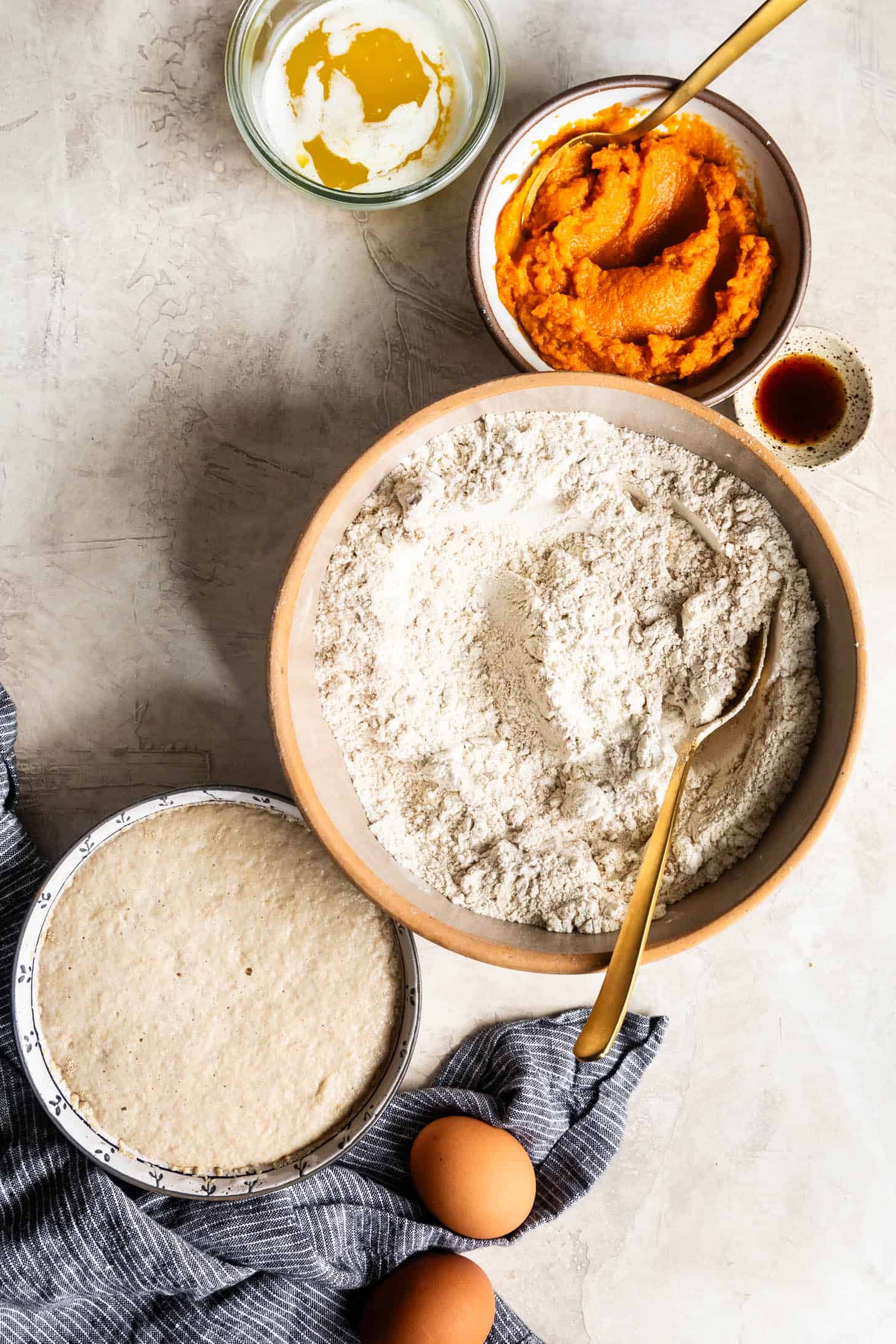
Ingredients for Gluten-Free Pumpkin Donuts
- Milk: These donuts call for an enriched dough using whole milk. The proteins in milk (caseins) can mimic gluten and help provide structure to the dough. From my experience testing gluten-free bread doughs with water versus milk, the milk aids in trapping the air, creating a better crumb texture of the baked dough. You can also use plant milk (such as oat), and unless you were eating them side by side, you might not notice a difference!
- Active dry yeast: Instant dry yeast can be used in a pinch (see below). In this recipe, the sugar and warm milk (105-110°F) activate the yeast, which is the leavener that allows the dough to rise, creating those fluffy air pockets.
- Granulated sugar: A small amount of sugar to create just a lightly sweetened dough.
- Large eggs: Provide structure to the dough.
- Canned pumpkin puree: Not pumpkin pie filling. I recommend a non-organic pumpkin puree, as organic pumpkin puree tends to have more liquid, which will negatively affect the texture of the dough.
- Unsalted butter: Adds moisture and flavor to the dough. Plant butter works too.
- Pure vanilla extract: For flavor!
- Four gluten-free flours: These gluten-free pumpkin donuts use gluten-free oat flour, millet flour, sweet rice flour, and tapioca flour. While four might seem like overkill, with these flours, you can make so many recipes on my site. Here are some that use all four flours, while others that use just three of the flours.
- Xanthan gum: These donuts use xanthan gum as the binder to hold the dough together, adding chewiness that mimics gluten.
- Spices and salt: Spices add the warm pumpkin spice notes to the donuts. Salt is essential, as it brings out the flavor and sweetness in the dough.
- Baking powder: To help them rise just a little more.
- Vegetable oil for frying: Use any neutral high-heat oil.
- Glaze, icing, or sugar for topping: Your choice!
Flour Substitutions for Gluten-Free Pumpkin Donuts
For all of the flours below, I used Bob's Red Mill brand or Koda Farms Mochiko. Each brand of flour varies in how finely ground it is. If you use different brands, your dough may vary and you might find you need to add a couple of tablespoons more flour or water to get the correct texture.
If making substitutions, I recommend subbing only 1-2 of the flours in the recipe at a time or your result may vary wildly.
Gluten-Free Oat Flour gives lightness and structure, with its warm and wholesome flavor coming through and pairing well with the fried glazed donut.
- Sub in by weight: If you don't have oat flour, you can make your own by grinding gluten-free rolled oats in a blender or food processor until fine, then sifting out any larger pieces. Alternatively, if you cannot tolerate oats, I would recommend the almond flour variation below. And if you cannot tolerate either oats or nuts, my next best recommendation would be to use the oat flour version, subbing out the oat flour by weight with Bob's Red Mill 1-to-1 flour.
Millet Flour is a neutral flour in texture and flavor that’s used almost as the mediator between the oat and sweet rice flour.
- Sub in by weight: sorghum flour, brown or white rice flour, or Bob's Red Mill 1-to-1 flour.
Sweet Rice Flour, made from sticky rice, is distinctively different than white rice or brown rice flour, and despite its name, it's not sweet. Sweet rice flour is the same flour used to make mochi, and as such, its stickiness helps to bind doughs together. In these donuts, it adds chewiness like a classic glazed donut.
- Substitution: In general, I don't recommend substituting sweet rice flour as I find it's essential. You can try subbing in Bob's Red Mill 1-to-1 flour or Tapioca Flour by weight, but your results will vary.
Tapioca flour adds chewiness and helps mimic the fluffiness of a classic yeast donut. It adds just a bit more softness and loftiness to the rise.
- Sub in by weight: arrowroot starch, potato starch, or Bob's Red Mill 1-to-1 flour.
Dairy-Free Gluten-Free Pumpkin Donuts
To make these pumpkin donuts dairy-free, just substitute the whole milk and unsalted butter with plant milk (such as oat milk) and plant butter. The results are nearly indistinguishable from the dairy version.
SMALL BATCH GLUTEN-FREE DONUTS
Don't need 16 donuts? You can easily halve the recipe to make just 8 donuts. Just follow the recipe as written, halving each ingredient. Tip: use a scale to make it super easy to halve!
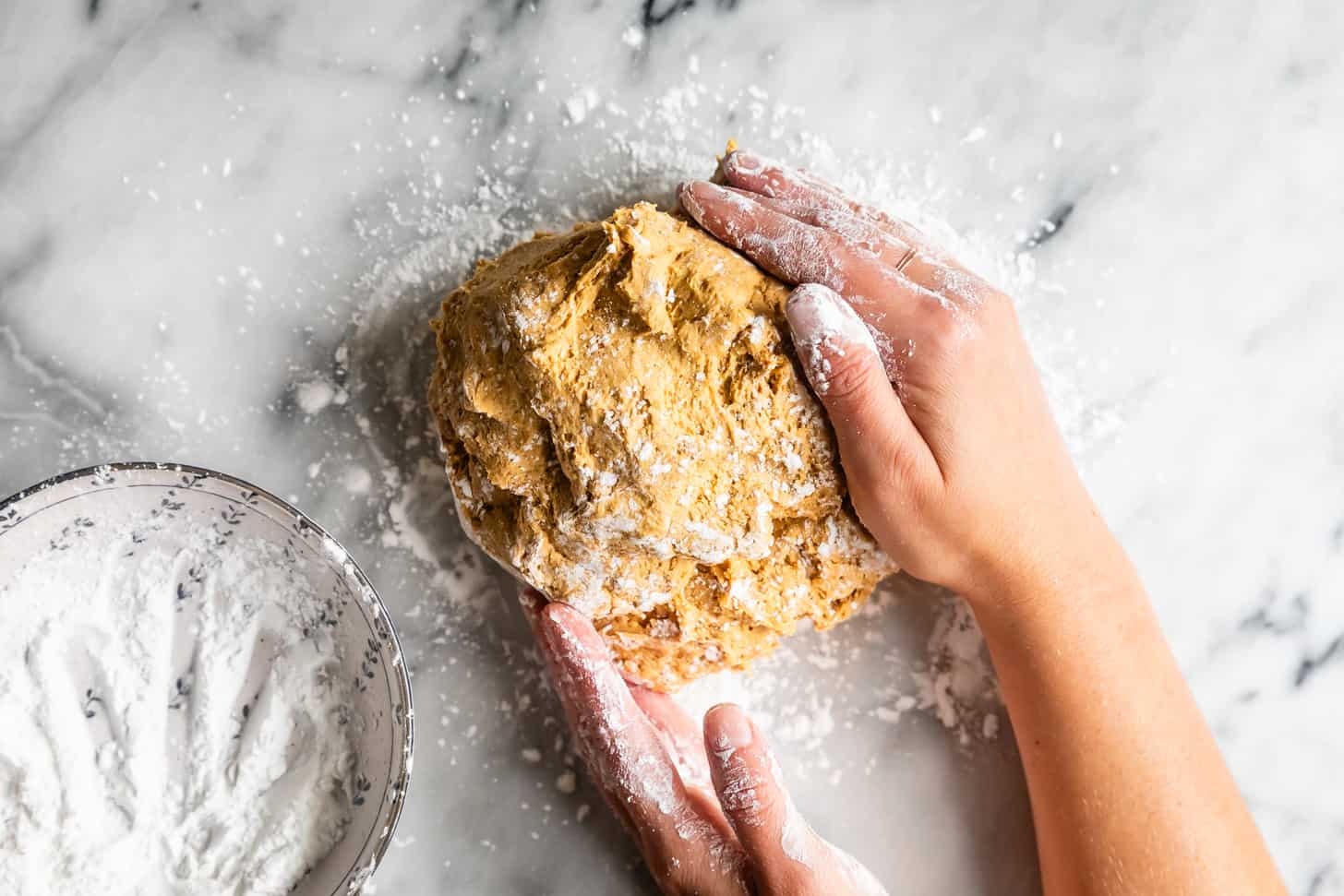
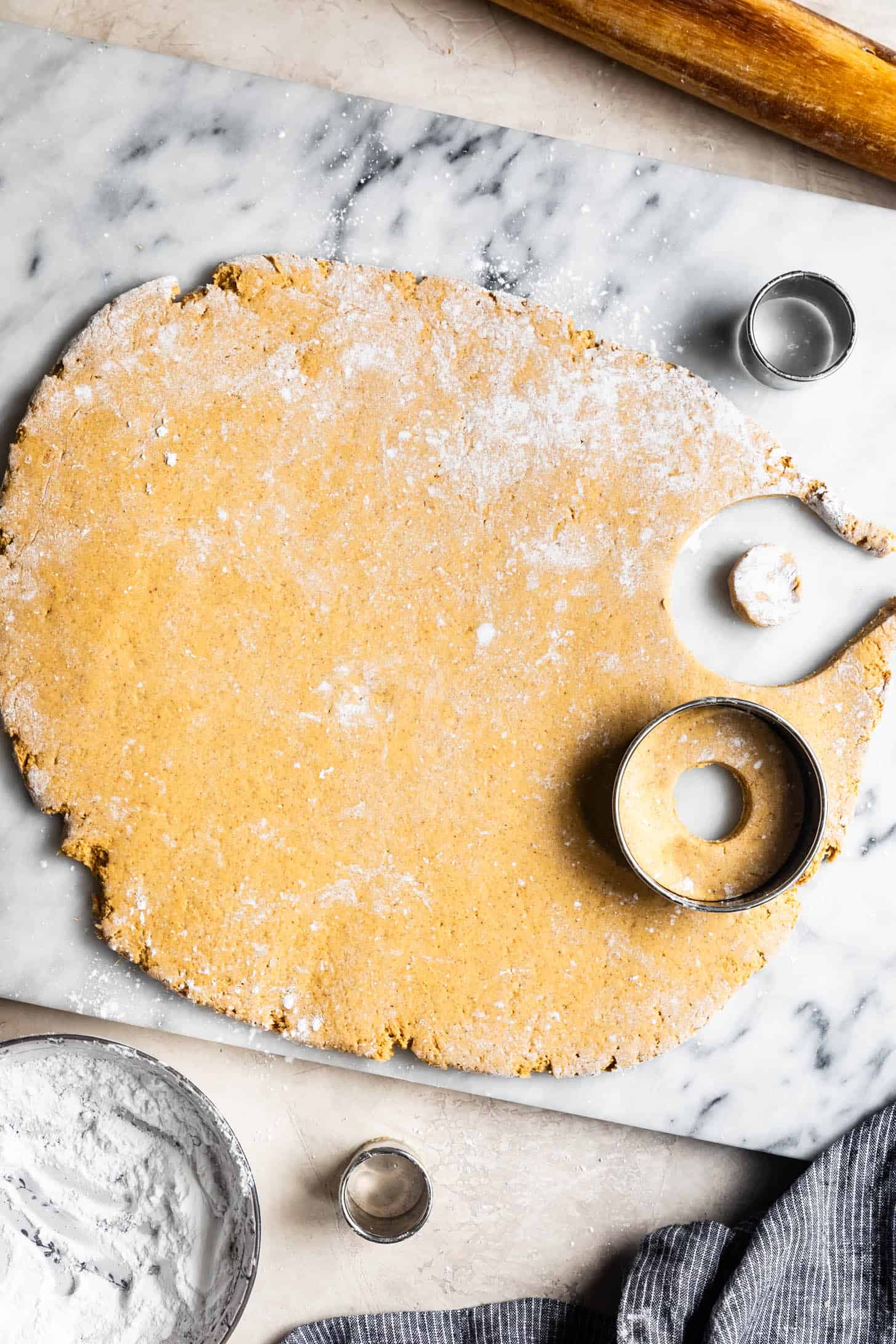
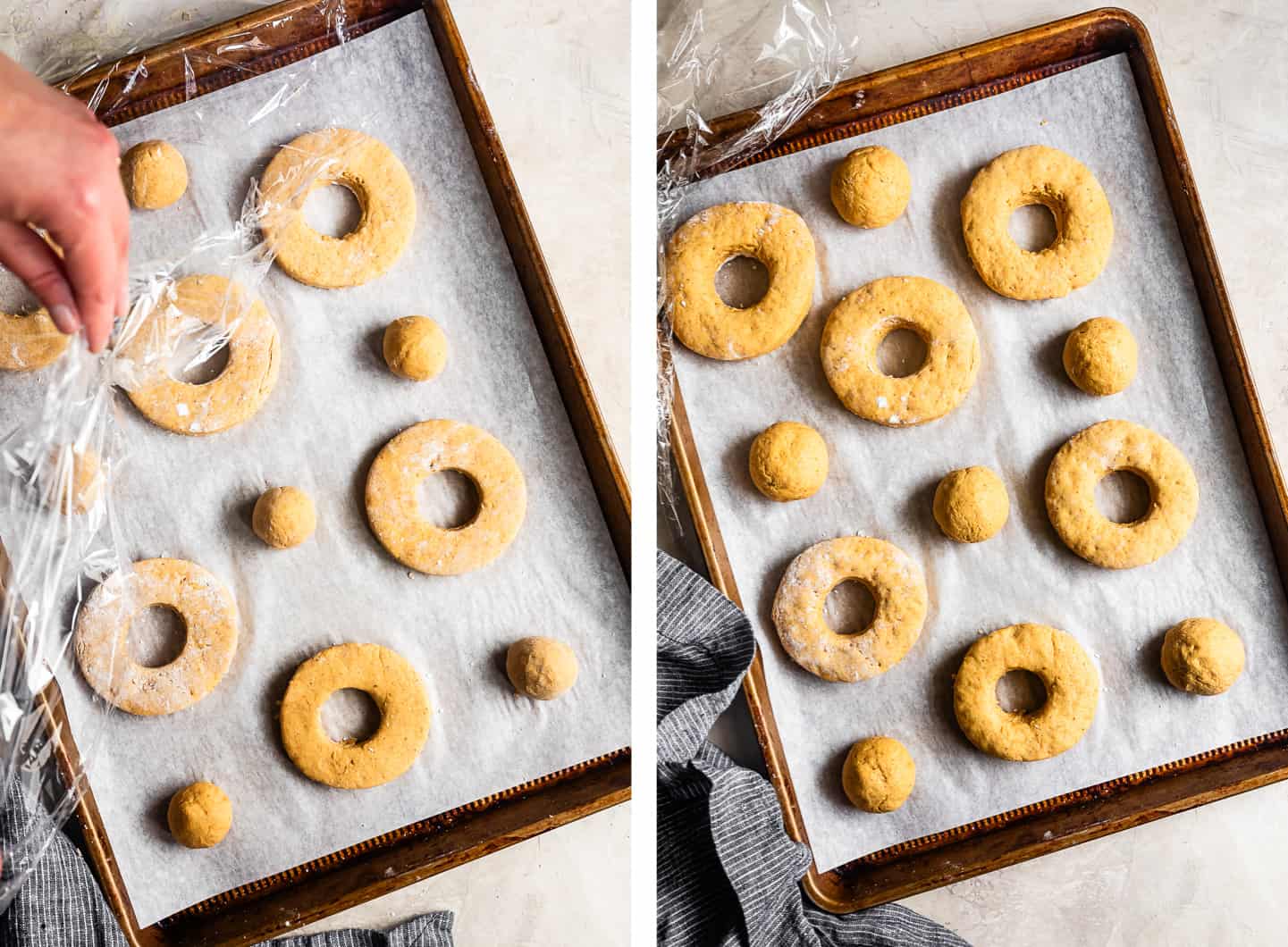
How to Make Gluten-Free Pumpkin Donuts
- Make the dough: While I recommend a stand mixer to make this yeasted dough, you can also use a hand mixer. The dough Is very sticky, so do not attempt to knead it by hand.
- Toss dough in tapioca flour: Dust your work surface well with tapioca flour before dumping the dough onto the surface. Sprinkle more tapioca flour on top of the dough and coat your hands in tapioca flour. Gently form the dough into a ball until the entire surface is covered with tapioca flour, then roll the dough into a ½ - ¾ inch thickness.
- Cut out your donuts: Use cutters to cut out your donuts and/or donut holes, using a bench scraper to help transfer your donuts to a parchment-lined baking sheet. I use 3 to 3.5-inch cutters with 1.5-1.75-inch holes. With tapioca-floured hands, knead the scraps into a ball and repeat.
- Let the dough rise. Cover with plastic wrap and let rise for 1 hour.
- Prepare the glaze, sugar, or icing. Whisk together the glaze ingredients or set a bowl of sugar for tossing fried donuts in.
- Fry the donuts. Heat 2-3 inches of oil to 360°F. Note, this is a bit cooler than normal frying temperature because the gluten-free dough needs to cook just a little longer and you don't want the outside to get too dark in the process. Fry 3-4 donuts at a time, 2 minutes on each side, until golden brown. Transfer to a wire rack placed over a baking sheet to cool slightly for 3-5 minutes. Repeat.
- Glaze the donuts. When you finish frying the next batch, dunk the slightly cooled donuts into the glaze on both sides. Place back on the wire rack. The glaze will set after about 20 minutes. For sugar donuts, toss the slightly cooled donuts in sugar all over.
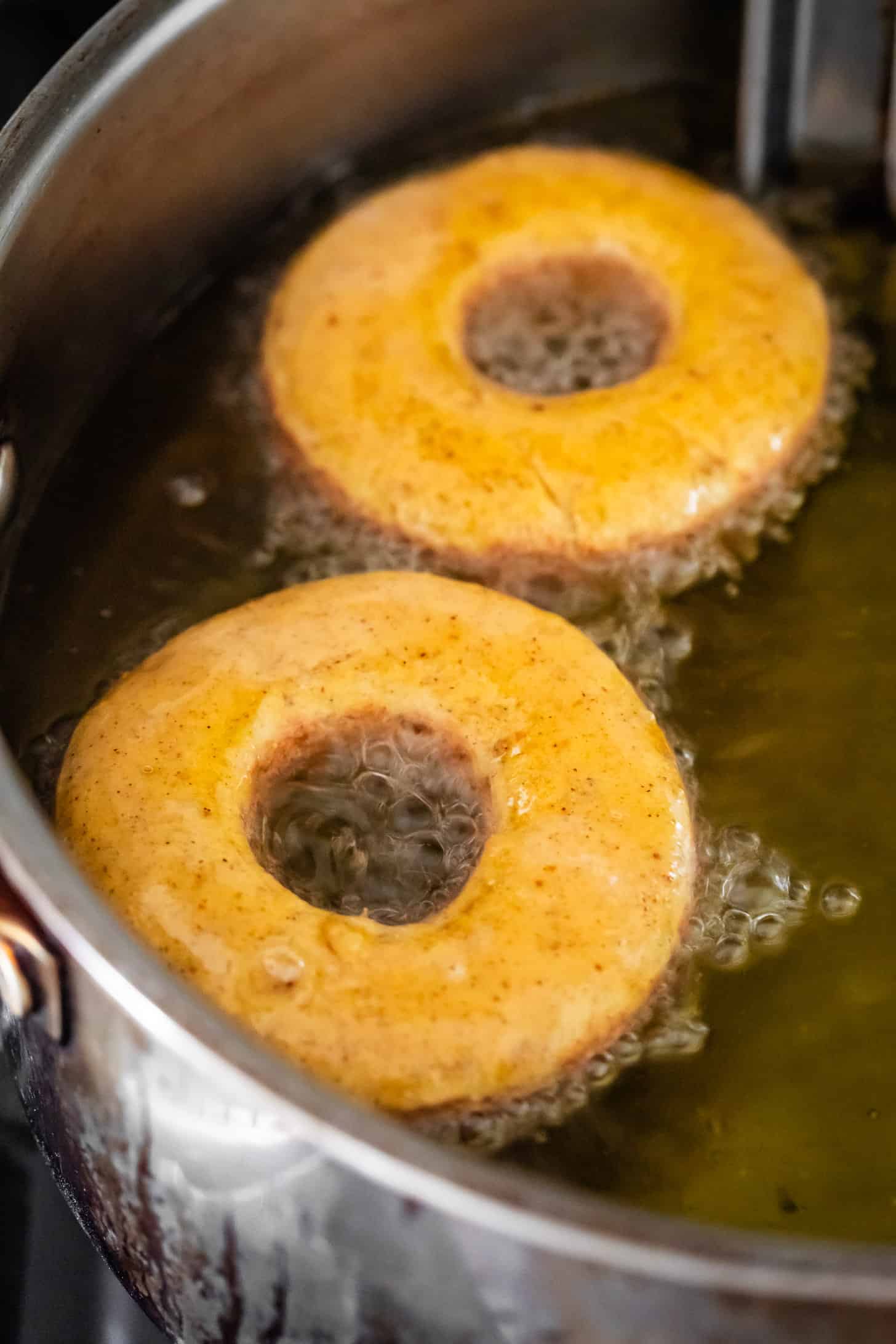
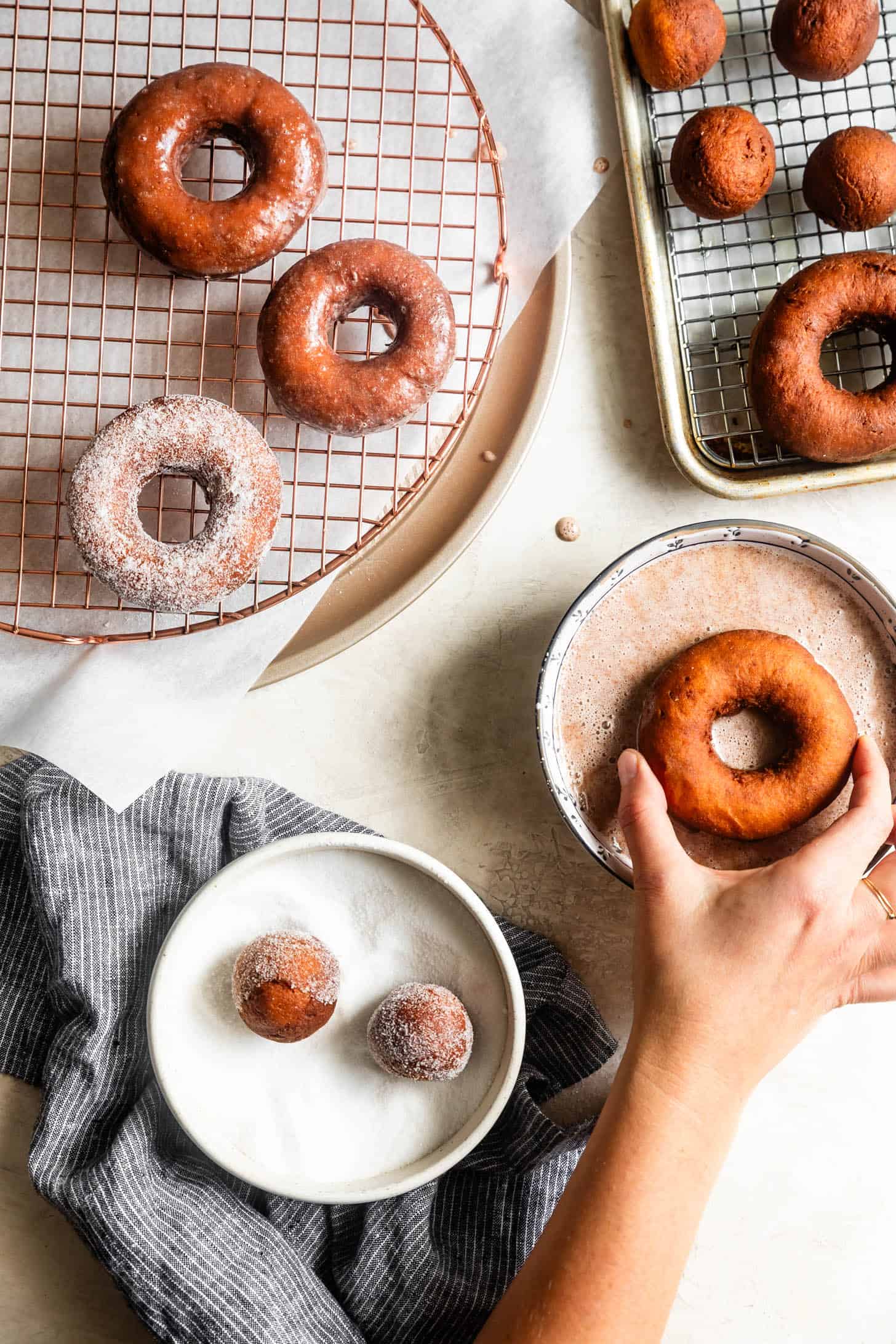
Frying Donuts in Oil
If frying donuts in oil feels intimidating to you, believe me, I can relate. Years ago, I swore I'd never fry in my kitchen. Today, I'm eating my words because it turns out frying is super easy! Here are my biggest tips:
- Use a large wide pot for frying. I like using a stockpot or large saucepan because the high sides keep the oil from splattering.
- Use a candy/deep-fry thermometer. Frying perfectly golden brown and crispy donuts with a soft slightly chewy center that isn't doughy requires having your oil at the right temperature, 360°F. Once you add the donuts to the oil, the temperature will drop, so increase the heat to account for that, keeping an eye that it doesn't get too hot.
- Save and reuse the oil. No need to toss your oil after one batch of donuts. After it cools, strain the oil well and place it in a clean container labeled "used frying oil." You can use the oil about 4-8 times for frying before tossing. I typically keep one used oil for frying sweet foods like donuts or churros and another separate one for frying savory foods like tempura. You'll know it's time to dispose of it by examining its appearance and smell (ex. if it's really dark and cloudy or smells rancid, it's time to toss it).

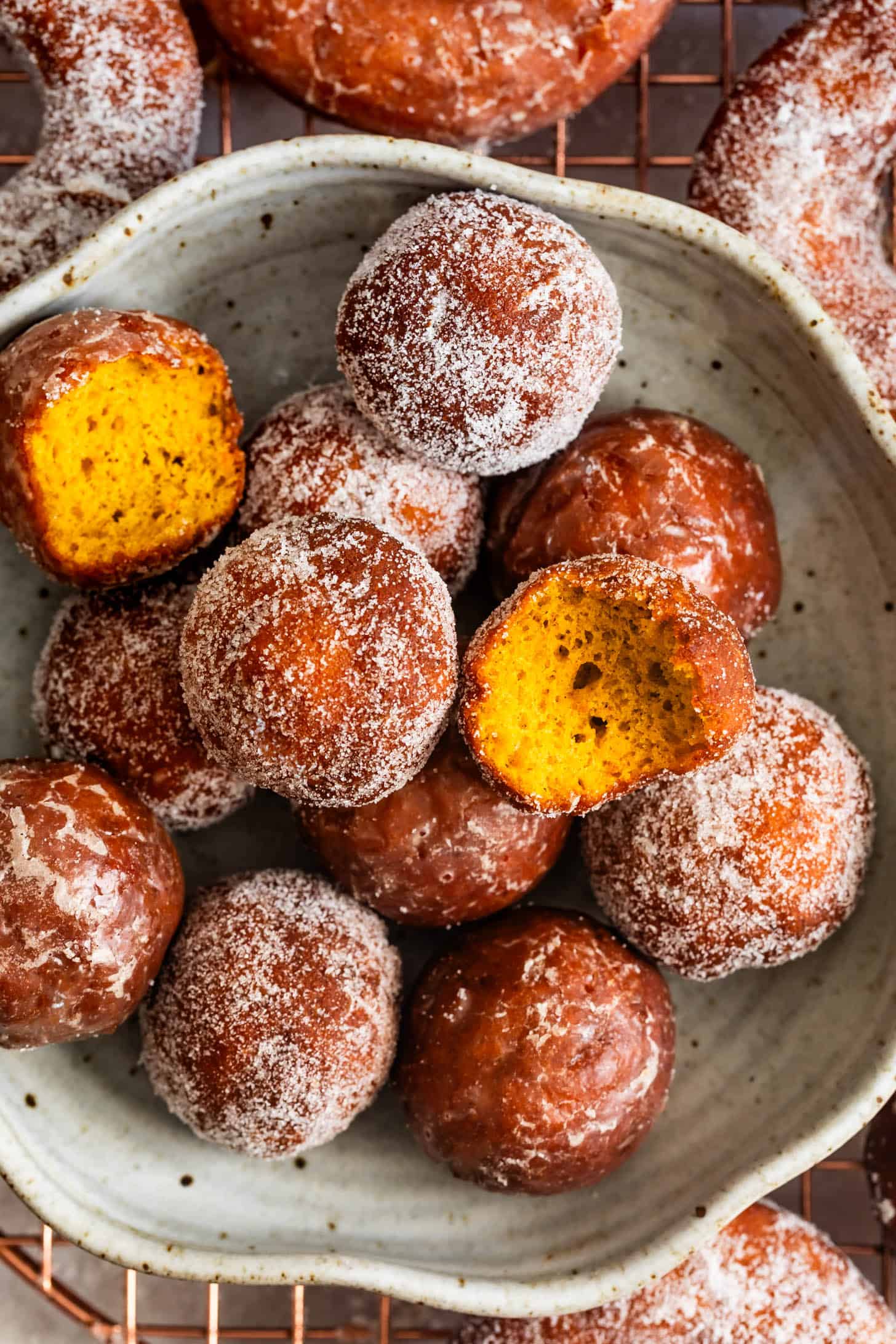
Gluten-Free Pumpkin Donut holes
Donut holes are so fun to eat and perfect for sharing at a party! To make donut holes, follow the recipe as written, but cut 1.5-2 inch rounds out of the dough and roll them into a ball with the palms of your hand.
Toppings for Gluten-Free Pumpkin Spice Donuts
Pictured here are a combination of glazed and sugar donuts. When it comes to topping the donuts you've got options:
- Cinnamon glaze: Dunk the warm donuts in a thin cinnamon glaze that sets up into a crisp sugary shell.
- Sugar: Toss the warm donuts in cinnamon for a classic sugar donut. Optionally dust them with cinnamon or pumpkin spice afterward. Note: I found when I pre-mixed the spices with sugar before tossing the donuts, the powdery spices wanted to stick to the donuts leaving the sugar behind, so it works best to first toss in sugar and then lightly dust with spices.
- Iced donuts with sprinkles: For sprinkle donuts, make a thicker glaze (chocolate, vanilla, or even cinnamon!) and dunk just the tops of the cooled donuts in the glaze, set them on the wire rack, and top with fun fall sprinkles.
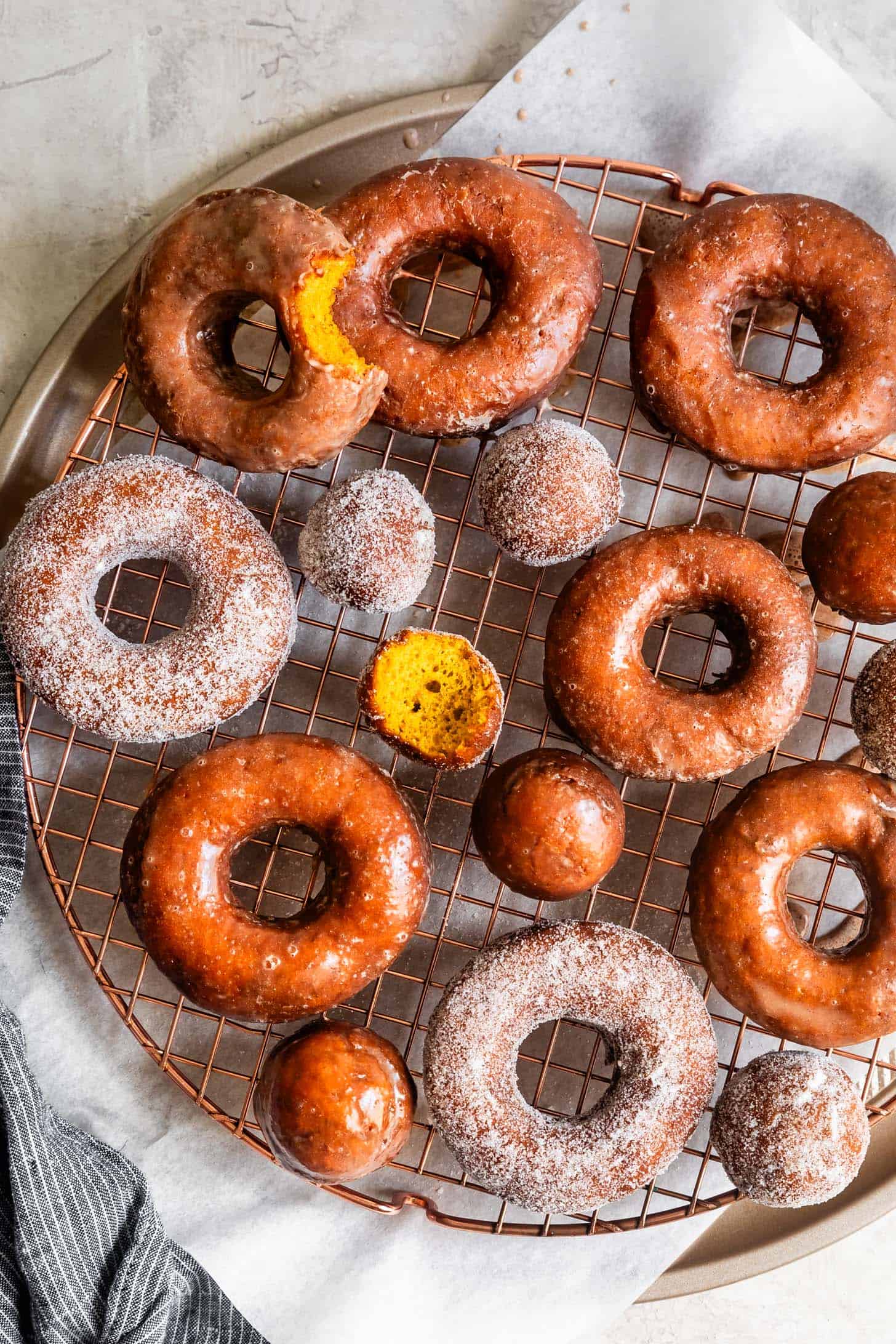
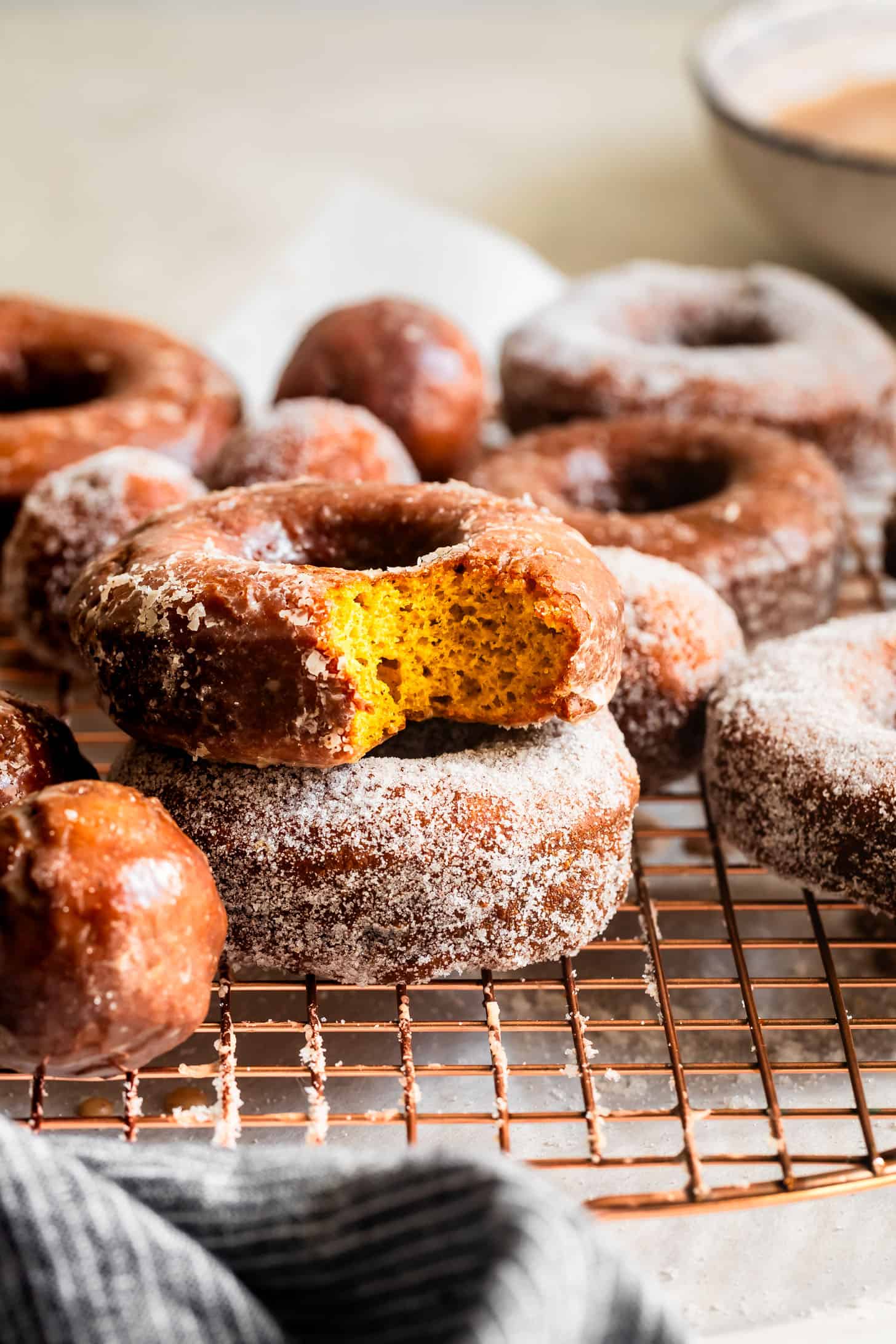
FAQ
Can I use instant yeast instead of active dry yeast?
Active dry yeast is preferred, but instant yeast will work in a pinch, The instant yeast donuts are not quite as fluffy.
If all you have is instant yeast, replace it 1:1. You do not need to activate it in the warm milk, so just add it to the dry ingredients. Continue with the rest of the recipe as written, including warming the milk. You may also find your dough rises a bit quicker with instant yeast.
How thick should I roll the dough?
Roll the dough into a ½ - ¾ inch thickness. The dough will rise quite a bit and puff up even more when fried.
Do I need a thermometer?
Yes. The oil temperature will greatly affect how well your donuts fry up. Too hot and they'll get too dark on the outside before the inside is cooked.
Even with the stove heat at a consistent temperature, the oil temperature will vary as you add donuts to the pot. Using a candy thermometer allows you to keep the oil at a consistent temperature.
Can I bake these pumpkin donuts instead of frying?
This recipe is specifically for a fried donut and will not work baked or in the air fryer.
If you'd like delicious gluten-free baked donuts, I'd recommend mochi donuts.
What if my donuts turn out doughy?
If your donuts are doughy on the inside, but still properly golden brown, this means the temperature of your oil is off. As I mentioned above, it's important to use a thermometer to monitor the temperature of the oil. If the oil is too hot, your donuts will brown and crisp up while the center remains doughy and undercooked.
If your donuts are neither golden brown nor cooked in the center, then they're just undercooked and need to fry longer. Make sure you only pull them out once both sides have turned deep golden brown.
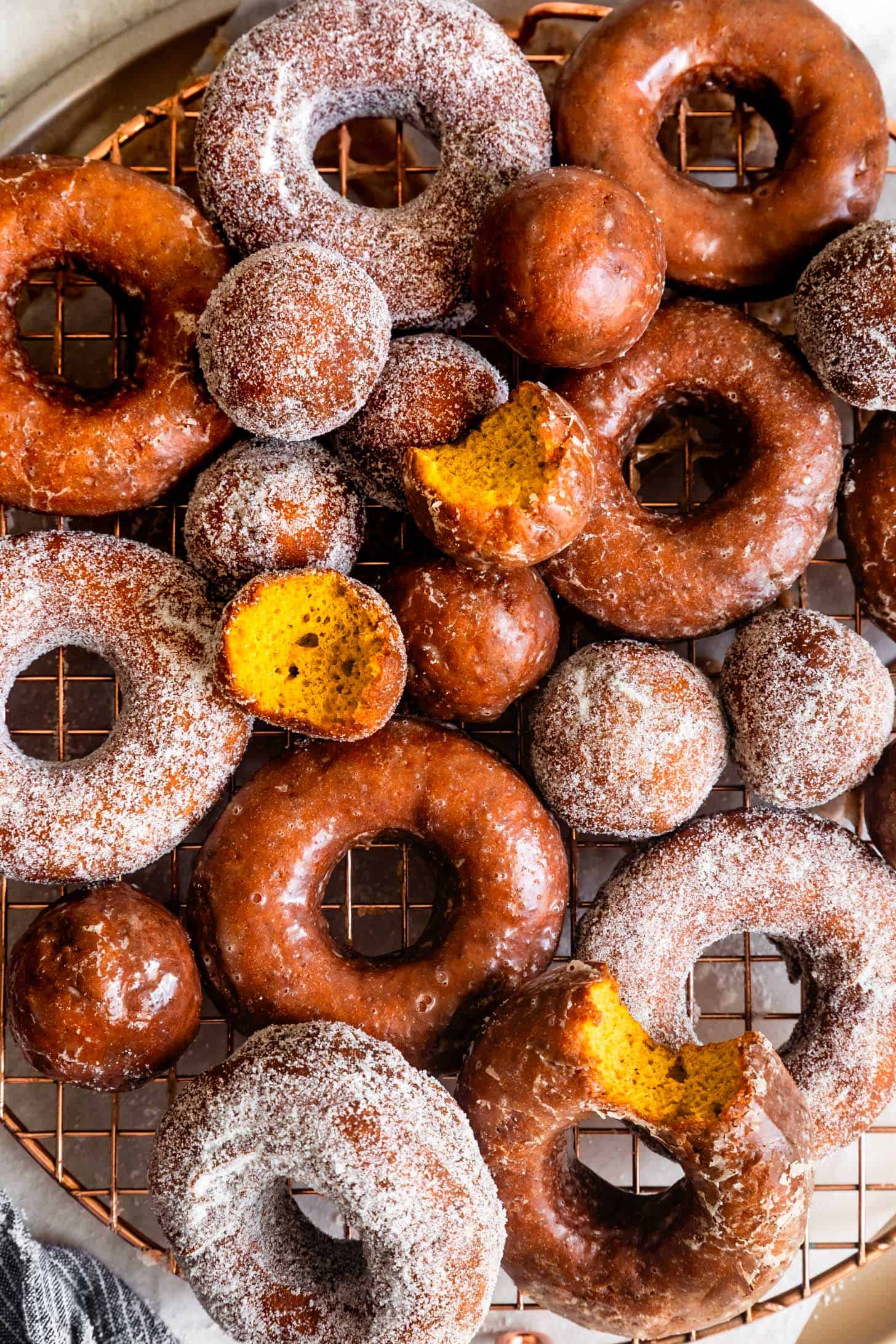
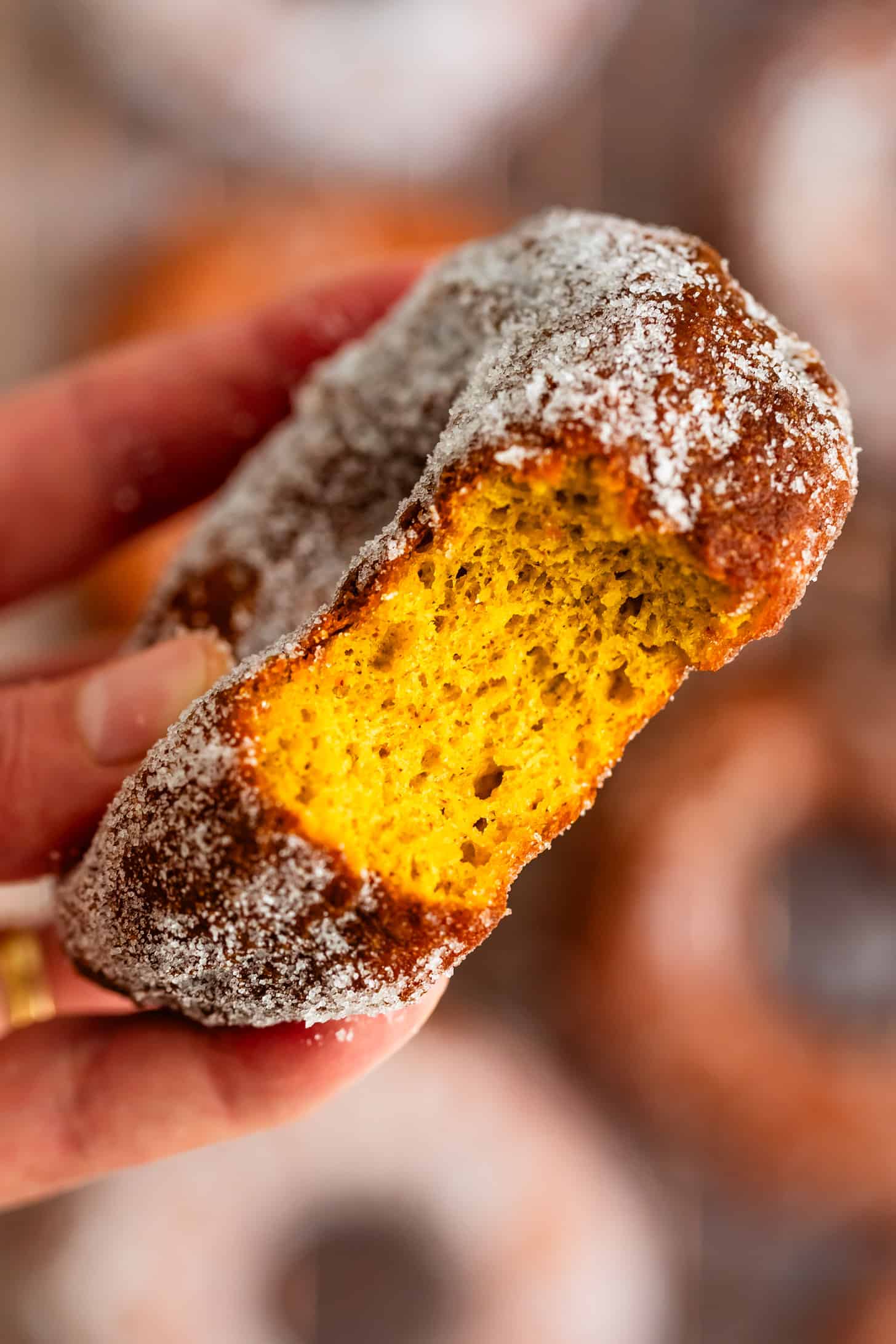
Making Donuts Ahead of Time
You can make these gluten-free pumpkin donuts in advance so all you have to do the morning of is bring them to room temperature and fry them up. Prep the donuts and let them rise, covered, overnight in the fridge. Pull the tray out 1 hour before frying and continue as written.
Letting the dough proof overnight in the fridge also enhances the yeast flavor a bit and makes for a super fluffy donut.
How to store Gluten-Free Donuts
Donuts are best served the same day you fry them. As they sit, the tender fluffy inside gets a bit denser, while the crisp fried crust gets softer.
If you have leftovers, store them in an airtight container for up to a day and warm them in the microwave for 10-15 seconds, or better yet, toss them in the air fryer at 400°F for 2 minutes, before serving.
More Gluten-Free Fried Recipes
Recipe

Gluten-Free Pumpkin Donuts
Ingredients
- ¾ cup + 1 tablespoon (195 g) whole milk, or plant milk
- 4 teaspoons active dry yeast, see note for instant yeast option
- ¼ cup granulated sugar
- 2 large eggs, room temperature
- ⅔ cup (151 g) canned pumpkin puree, not pumpkin pie filling
- 7 tablespoons unsalted butter, melted and slightly cooled (or plant butter)
- 1 teaspoon pure vanilla extract
- 189 g (1¾ cup) Bob’s Red Mill gluten-free oat flour
- 93 g (½ cup + 2 tablespoons) Bob’s Red Mill millet flour
- 100 g (½ cup + 2 tablespoons) sweet rice flour, also called "Mochiko", distinctly different than brown rice flour or white rice flour
- 84 g (¾ cup) Bob’s Red Mill tapioca flour
- 2 teaspoons Bob’s Red Mill xanthan gum
- 2 teaspoon ground cinnamon
- ½ teaspoon ground ginger
- ½ teaspoon ground nutmeg
- ¼ teaspoon ground cloves
- 1 teaspoon kosher salt
- 1 teaspoon baking powder
- 3-4 cups vegetable oil for frying
- 3 cups powdered sugar, sifted
- 1 teaspoon ground cinnamon
- ½ cup whole milk, or plant milk
- ½ teaspoon pure vanilla extract
- 1 cup granulated sugar
- optional: ½ teaspoon ground cinnamon
- 1½ cup powdered sugar, sifted
- ½ teaspoon ground cinnamon
- ½ teaspoon pure vanilla extract
- 2½ tablespoons whole milk, or plant milk
- optional: ¼ cup festive sprinkles
INSTRUCTIONS
- Activate the yeast. In the bowl of your stand mixer fitted with the paddle attachment (see note), mix together the warm milk, sugar, and yeast. Let sit for 10 minutes while the yeast activates and foams. Note: If your yeast hasn't foamed up after 10 minutes, you may have bad yeast and you should try again with a new packet.
- Mix dry ingredients. In a medium bowl, whisk together all of the dry ingredients: oat flour, millet flour, sweet rice flour, tapioca flour, xanthan gum, spices, kosher salt, and baking powder.
- Make the dough. Once the yeast has foamed, add the pumpkin, eggs, melted butter, vanilla, and about 1 cup of the dry mixture to the stand mixer and mix until completely smooth, scraping down the sides as needed. With the mixer on low, slowly mix in the remaining dry ingredients, scraping down the sides as needed. Mix on high speed for 2 minutes. The dough will be very soft and sticky.
- Toss in tapioca flour and roll out the dough. Coat your work surface well with tapioca flour. Use a spatula to dump the dough onto your work surface. Sprinkle more tapioca flour on top of the dough and ensure your hands are coated in tapioca flour before touching the dough. This dough is much softer and sticker than gluten dough. Gently form the dough into a ball with the surface of the dough entirely dusted with tapioca flour so it is no longer sticky. Roll the dough into ½ - ¾ inch thickness.
- Cut out your donuts. Use a sharp round cutter to cut out your donuts and/or donut holes. I use 3 to 3.5-inch cutters with 1.5-1.75-inch holes. Use a bench scraper to transfer each donut to a parchment-lined baking sheet, at least 2 inches apart. For donut holes, roll the dough into a ball with the palms of your hands. With tapioca-floured hands, knead the scraps into a ball and repeat until you've made all the donuts.
- Let the dough rise. Cover with plastic wrap and let rise in a warm place (such as the proofing setting on your oven) for 1-1.5 hours. Note: if making ahead, you can skip this rise and place the covered donuts directly in the fridge overnight. The next day, pull the baking sheet out of the fridge and let it sit on the counter for an hour before frying and continue as written.
- Prepare the glaze, sugar, or icing. Whisk together the glaze or icing ingredients or set a bowl of sugar for tossing fried donuts in.
- Fry the donuts. Heat at least 2 inches of oil to 360°F. This is a bit cooler than normal frying temperature because the gluten-free dough needs to cook just a little longer and you don't want the outside to get too dark in the process. Use a candy thermometer to keep the oil at a consistent temperature. Place a wire rack over a baking sheet nearby. Carefully drop your donut or donut hole into the oil. Fry 3-4 donuts at a time, 2 minutes on each side, until golden brown. Transfer to the prepared rack to cool slightly for 3-5 minutes. Repeat.
- Glaze the donuts. When you finish frying the next batch, dunk the previous batch of slightly cooled donuts into the glaze or bowl of sugar on both sides. Place back on the wire rack. The glaze will set after about 20 minutes. Optionally dust the sugar donuts in cinnamon or pumpkin spice. If doing thicker icing with sprinkles, let the donut cool 10 minutes before dunking in the icing.
- Enjoy! For best results, serve donuts the same day. If you have leftovers, store them in an airtight container for up to a day and warm them in the microwave for 10-15 seconds, or better yet, toss them in the air fryer at 400°F for 2 minutes, before serving.



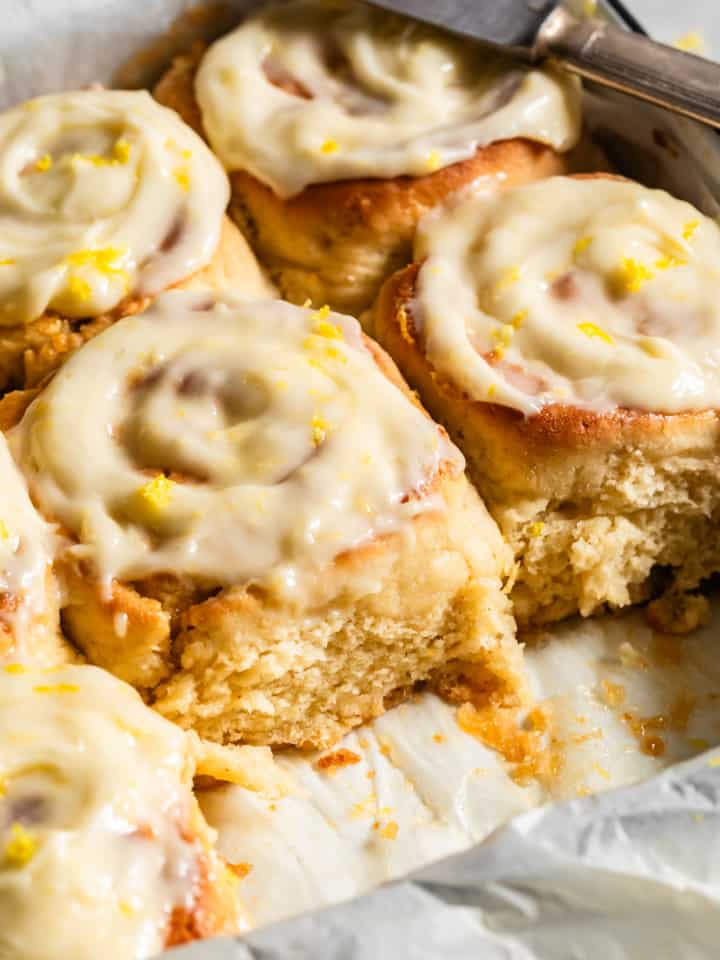
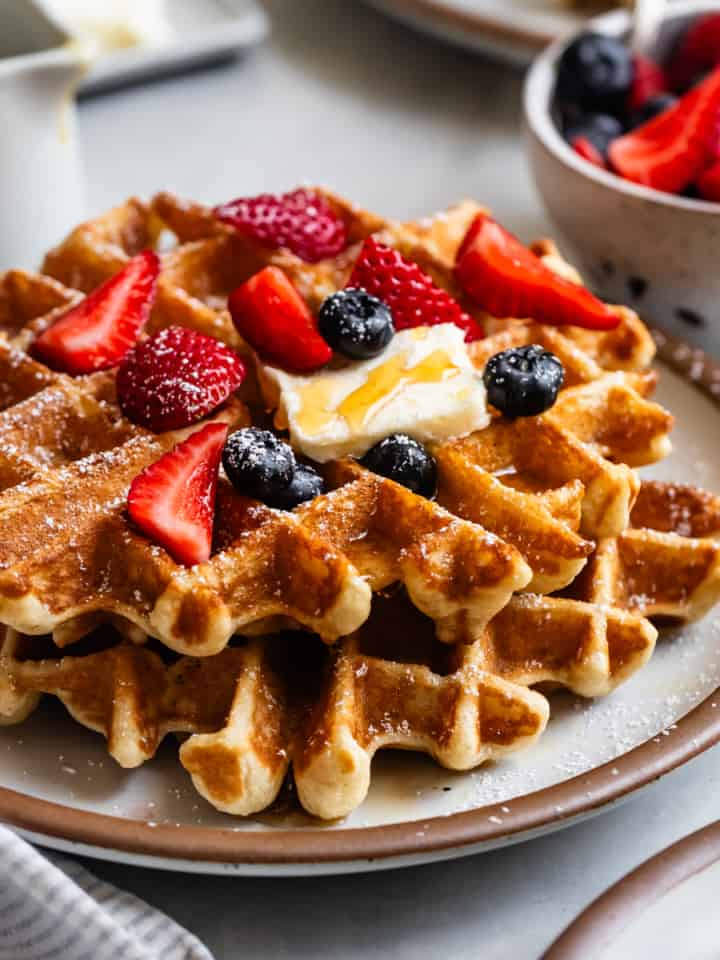
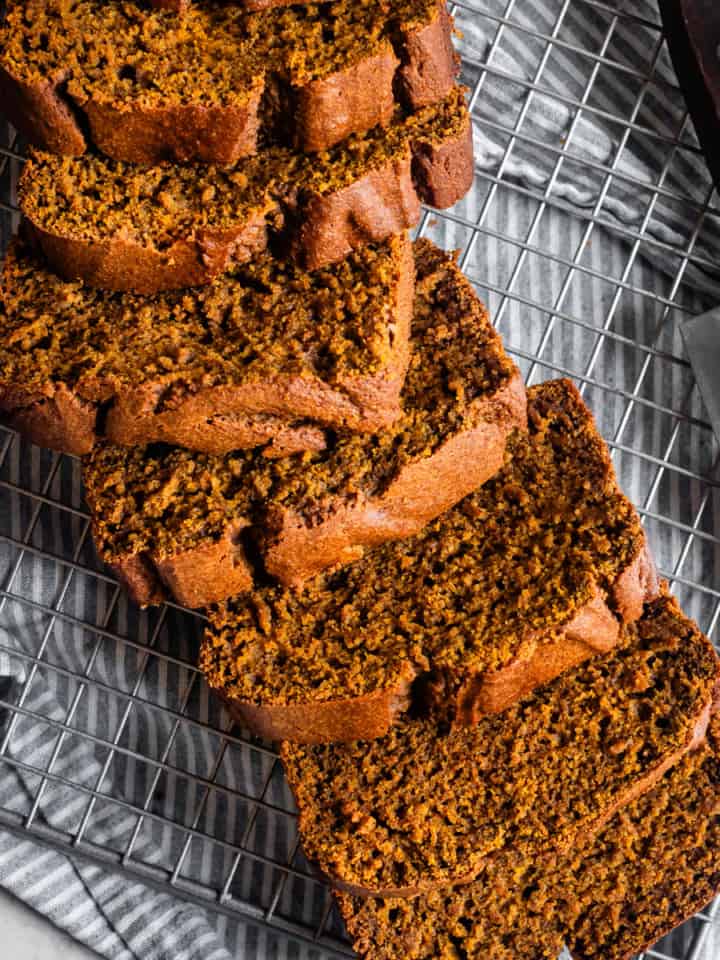
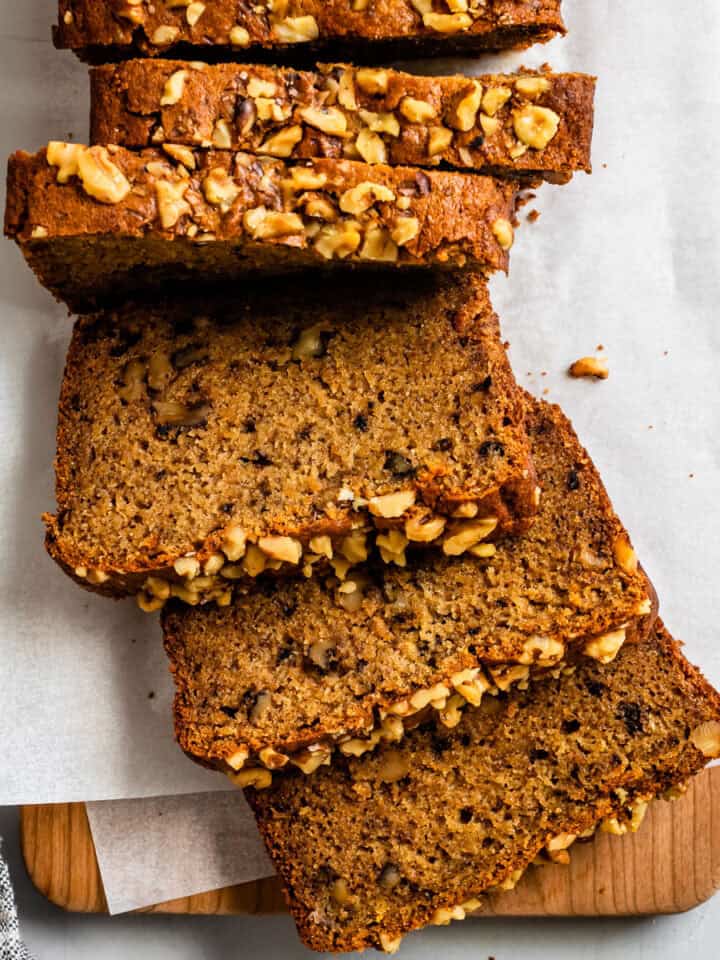

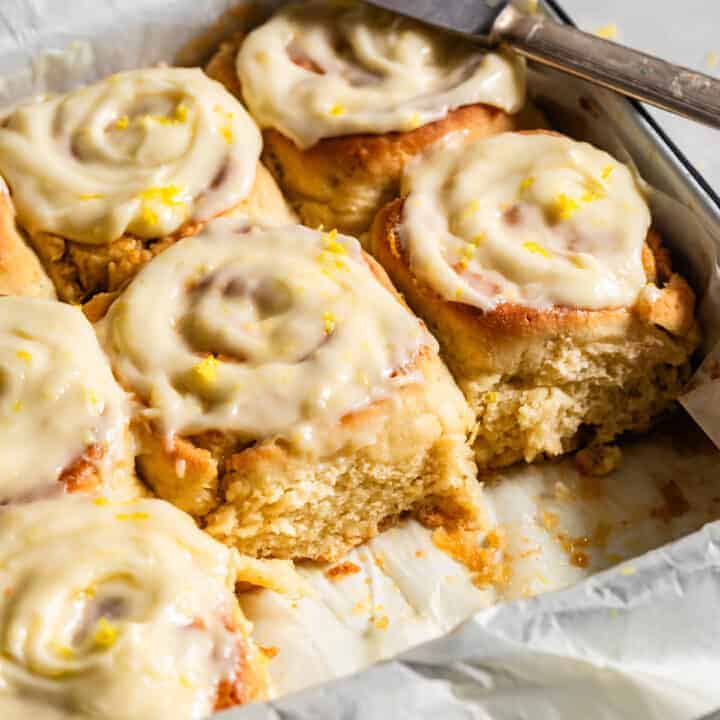
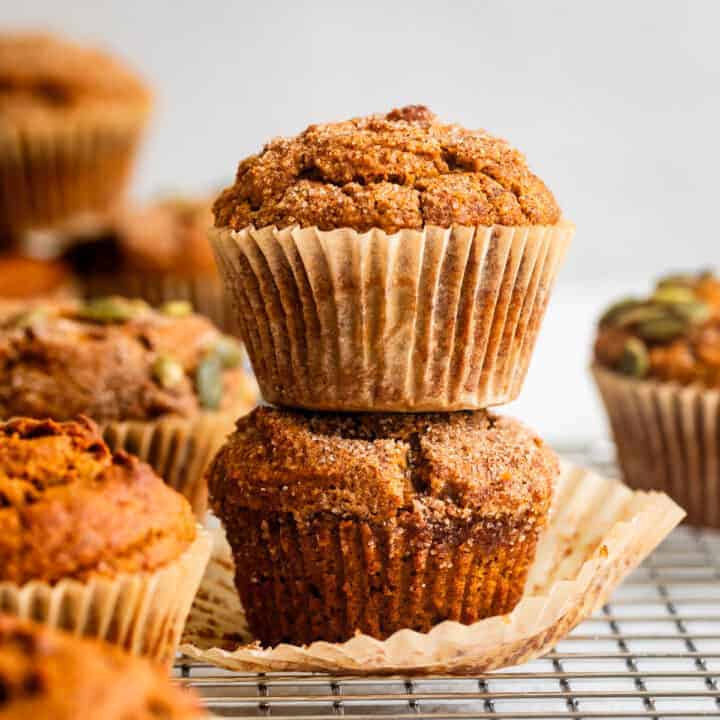
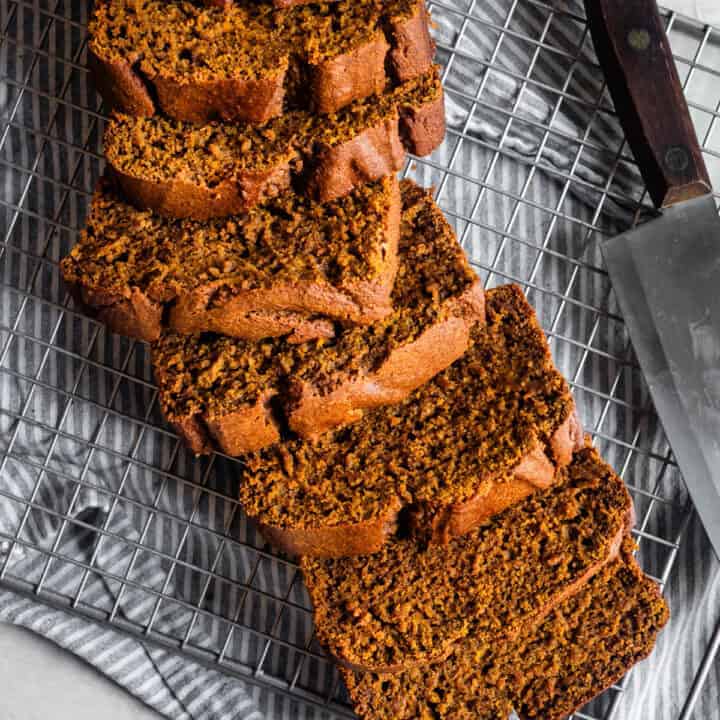
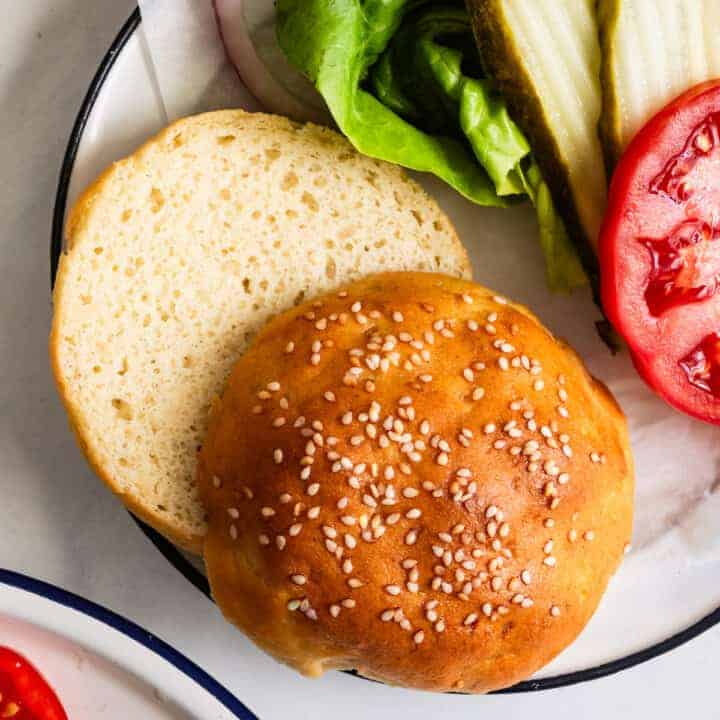
Comments
No Comments